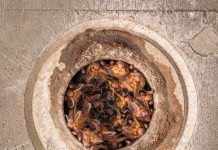Revised version maintains total cleanup is ‘infeasible’ for
water basin
Morgan Hill – Olin Corporation’s latest cleanup plan argues that removing every ton of perchlorate it’s dumped into the water basin would “adversely affect groundwater management” and would be “inconsistent with the maximum benefit to the people of the state.”
The 138-page report also states a total cleanup of the South Valley water table, from which more than 1,500 wells draw water, could “unreasonably affect present and anticipated beneficial uses of the water” and would result in “water quality less than that prescribed” in the Water Quality Control Plan for the Central Coast Region.
Olin Corporation is responsible for a 9-mile plume of perchlorate stretching south from the company’s old road flare plant in Morgan Hill. Perchlorate is known to interfere with the natural function of the thyroid gland by blocking the uptake of iodide. Studies show women with low levels of iron at particularly at risk. The alleged contamination, first reported in 2003, spreads from Olin’s old site on Tennant Avenue and travels south east of U.S. 101 all the way past Masten Avenue.
The cleanup plan was submitted Wednesday to the Central Coast Regional Water Quality Control Board, where officials say it will be under review until the end of January.
The report’s purpose is to assess how much pollution Olin caused and what it plans to do about it. The company, which owns a factory on Tennant Avenue in Morgan Hill that manufactured road flares for 32 years from 1952 to 1988, submitted the report after regulators two months ago rejected a prior version. Additionally, the first report was roundly criticized by the city of Morgan Hill, San Martin residents and the Santa Clara Valley Water District for avoiding “pump and treat” options and favoring 20 years of passive monitoring.
Regulators said Olin did not do a good enough job identifying how much pollution it caused and ordered the company to hand in a revised report.
Morgan Hill City Manager Ed Tewes has not seen the report, but is growing frustrated with the lack of apparent progress.
“We have acknowledged the comlexity of this case, but we have also expressed our disappointment with the pace of this regulatory process,” Tewes said. “However, we are hopeful the Central Coast Regional Water Quality Control Board will adopt a comprehensive cleanup abatement order at its next meeting in February for the entire basin, including the part of the basin from which Morgan Hill draws its domestic water supply.”
The new report argues that a total cleanup of the basin would be too expensive and unnecessary because perchlorate levels are below the state’s public health goal of 6 parts per billion.
Olin also submitted a work plan for the area surrounding the Tennant Avenue factory, where the highest concentrations of the thyroid-damaging chemical were found. The company plans to pump polluted water to the surface and clean it up, but still needs to devise what to do with the treated water. Olin will likely hold discussions with local public water agencies that could add the treated water to their supply systems.
Tony Burchyns covers Morgan Hill for The Times. Reach him at (408) 779-4106 ext. 201 or tburchyns@morganhilltimes.







